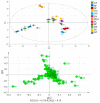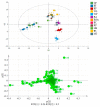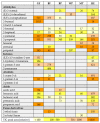Changes in Volatile Compound Profiles in Cold-Pressed Oils Obtained from Various Seeds during Accelerated Storage
- PMID: 33430033
- PMCID: PMC7827483
- DOI: 10.3390/molecules26020285
Changes in Volatile Compound Profiles in Cold-Pressed Oils Obtained from Various Seeds during Accelerated Storage
Abstract
Cold-pressed oils are highly valuable sources of unsaturated fatty acids which are prone to oxidation processes, resulting in the formation of lipid oxidation products, which may deteriorate the sensory quality of the produced oil. The aim of the study was to determine the main volatile compounds which differentiate examined oils and could be used as the markers of lipid oxidation in various oils. In the experiment, cold-pressed oils-brown flaxseed, golden flaxseed, hempseed, milk thistle, black cumin, pumpkin, white poppy seed, blue poppy seed, white sesame, black sesame and argan oils from raw and roasted kernels-were analyzed. To induce oxidative changes, an accelerate storage test was performed, and oils were kept at 60 °C for 0, 2, 4, 7 and 10 days. Volatile compound profiling was performed using SPME-GC-HRToFMS. Additionally, basic measurements such as fatty acid composition, peroxide value, scavenging activity and phenolic compound contents were carried out. Multivariate statistical analyses with volatile compound profiling allow us to differentiate oils in terms of plant variety, oxidation level and seed treatment before pressing. Comparing black cumin cold-pressed oil with other oils, significant differences in volatile compound profiles and scavenging activity were observed. Compounds that may serve as indicators of undergoing oxidation processes in flaxseed, poppy seed, milk thistle and hemp oils were determined.
Keywords: GC-HRToFMS; cold-pressed oil; multivariate analysis; volatile compounds.
Conflict of interest statement
The authors declare no conflict of interest.
Figures




References
-
- Gunstone F.D., Harwood J.L., Padley F.B. The Lipid Handbook. 2nd ed. CRC Press; Boca Raton, FL, USA: 1994.
-
- Ramadan M.F. Healthy blends of high linoleic sunflower oil with selected cold pressed oils: Functionality, stability and antioxidative characteristics. Ind. Crops Prod. 2013;43:65–72. doi: 10.1016/j.indcrop.2012.07.013. - DOI
-
- Wei C.Q., Liu W.Y., Xi W.P., Cao D., Zhang H.J., Ding M., Chen L., Xu Y.Y., Huang K.X. Comparison of volatile compounds of hot-pressed, cold-pressed and solvent-extracted flaxseed oils analyzed by SPME-GC/MS combined with electronic nose: Major volatiles can be used as markers to distinguish differently processed oils: Volatile compounds of different processed flaxseed oils. Eur. J. Lipid Sci. Technol. 2015;117:320–330. doi: 10.1002/ejlt.201400244. - DOI
-
- Kiralan M., Çalik G., Kiralan S., Ramadan M.F. Monitoring stability and volatile oxidation compounds of cold-pressed flax seed, grape seed and black cumin seed oils upon photo-oxidation. J. Food Meas. Charact. 2018;12:616–621. doi: 10.1007/s11694-017-9674-3. - DOI
MeSH terms
Substances
Grants and funding
LinkOut - more resources
Full Text Sources
Other Literature Sources
Medical
Miscellaneous

